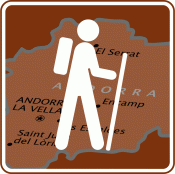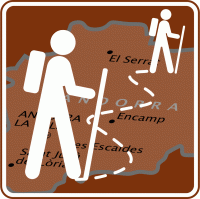The Art of Writing a Story About Walking Across Andorra
Travel Stories: He traversed an entire nation in a long weekend. Now Rolf Potts shows how you can impress members of the opposite sex and write a textbook-perfect travel article in eight easy steps.
12.30.05 | 1:56 PM ET
 Art by Jeff Wilson.
Art by Jeff Wilson.I. Many Travel Stories Begin as an Attempt to Impress Pretty Women
A. Once you have walked across the small Pyrenean nation of Andorra, you should proceed to Barcelona. Here, you will look for a nightclub called L’Arquer. According to your guidebook, L’Arquer contains a fully functioning archery range, and you are intrigued by the idea that one can shoot bows and arrows inside a nightclub. As with Andorra, you are attracted by L’Arquer because you find it charming that such a place exists.
B. In actuality, of course, L’Arquer will not likely live up to your expectations. The archery range, for example, will probably be in a separate, cordoned-off area, and your fantasies of chugging beers while shooting arrows over crowds of drunken revelers will not come true. For this reason, you will not look very hard for L’Arquer, and you will end up settling for a pub called Shanghai. This way, L’Arquer will remain perfect in your imagination—unlike Andorra, the memory of which has now been tainted with jagged brown ridges, chintzy souvenirs and drunken Scotsmen.
C. In the Shanghai pub, you will meet a Canadian woman named Lisa, who has come to Spain for two weeks of vacation. Eventually, she will ask you what you’re here for, and you will tell her that you just walked across Andorra. Lisa isn’t exactly sure what Andorra is, so the implicit gag (that Andorra is in fact a very small country, quite easy to walk across) is lost on her. Instead, she asks a neutral question: “How was it?” You reply that it was quite interesting.
D. After this, there will be a pause, which implies that Lisa wants you to elaborate. This is when the real Andorra story begins. What immediately follows the pause will not be the final and definitive story, but it will set the tone for how you’ll remember Andorra in the future. This is where you begin to pick and choose, to play games with reality, to separate the meaningful from the mundane and hold it up for display. Later, when you are writing the story down, you will add details of history and culture—but for now you just want to hold Lisa’s attention, because she has clear blue eyes and a captivating smile.
E. Skipping over the actual details of the hike, you tell Lisa about the Festa Major celebration in Andorra la Vella. Here, a group of mentally handicapped Andorrans singled you out from the crowd and cheerfully bullied you into joining them in a Catalan dance called the sardana. You choose to reveal Andorra through this story because it’s funny and self-deprecating, and you want to single yourself out to Lisa as a charmed person who is instinctively adored by retards.
F. The story goes fairly well upon first telling, save the fact that: (a) Lisa seems faintly offended when you use the word “retards”; and (b) You flub the phrasing near the end of the story, inadvertently implying (to Lisa’s ears) that you were insensitive to the mentally handicapped Andorrans while you were dancing with them. You make a mental note to sharpen the clarity of your phrasing, since you were not, in fact, acting insensitive when it actually happened.
 Art by Jeff Wilson.
Art by Jeff Wilson.II. Historical Details Make it Look Like You Know What You’re Talking About
A. After you have left Spain and returned to your home, you will decide you need to know more facts about Andorra before you properly begin to compose your story. Reference books and websites tell you that Andorra has 67,000 residents, only 33 percent of whom are Andorran citizens. Andorra has an area of 180 square miles. This is half the size of New York City, but two-and-a-half times larger than Washington, DC. Since you don’t want to make your hike sound too easy, you will use the Washington comparison when composing your Andorra story.
B. You’ll try to spruce up basic facts by clumping them together in a telling manner. Start by saying that Andorra has no airports, no trains, and no independent universities. Mention that Andorra’s small army has not fought a war for 700 years, and that most of its ammunition consists of blank bullets used for public ceremonies. Point out that, while Andorra has a National Automobile Museum, it did not have substantial roads until the middle of the 20th century. If possible, say: “More like a neighborhood than a country, Andorra’s tourism boom has transformed it into a peaceful suburb of ski runs, luxury hotels and duty-free shopping.”
C. Touch on the history of Andorra, but—since this is primarily a travel story—try to deal with it in a concise manner. Write: “Andorra is the lone remaining legacy of Charlemagne’s ‘March States,’ which were created to keep Muslim Moors out of Christian France in the 9th century.” Then jump forward a few centuries to describe how, in the 1200s, a local power struggle between a French count and a Spanish bishop led to a compromise that made Andorra nominally sovereign. “Called the ‘Pariatges,’” you will write, “this treaty plays French and Spanish influences off one another, and has ensured Andorra’s independence for centuries.”
D. Mention that, to this day, power is officially shared by the president of France and the bishop of Urgell in Spain. Say: “Thus, Andorra has the current distinction of being the only nation in the world to have two heads of state—neither of whom live in Andorra.”
III. Editors Are Impressed By Tidy Narrative Formulas
A. Now that you have prepared the historical facts, you must choose a manner of storytelling. Were you writing a book about Andorra, you might begin your story from a personal or emotional premise. You might say, for example, that your lover has just left you, and you resolved to walk across Andorra in an effort to heal your pain. Or, you might say that your home was lacking in good taste or authenticity, and you walked across Andorra to discover an older and more genuine way of life. Or, you might say that you’ve been fascinated with Andorra since childhood, and to walk it’s breadth would be to actualize a lifelong dream.
B. You are not, however, writing a book. Nor did you go to Andorra to heal your pain, seek a more genuine way of life, or actualize a lifelong dream. Rather, your Andorra sojourn was an extension of a trip to Paris, where you were teaching a seminar in (of all things) travel writing. As you walked across Andorra, in fact, your backpack contained a folder full of student papers. Every so often, you took these papers out and wrote things like: “Show how the villagers act, don’t tell.” Or: “Establish that you are inside the castle before you introduce the janitor.” Or: “Describe what the geishas looked like.” Or: “Don’t give away the samba dancer’s secret at the beginning.” Or: “Tell me more about the one-legged man with the sausage.”
C. Regardless of what happened to you in Andorra, you must choose a template.
(1) You could, for example, present yourself as a connoisseur who traveled to Andorra to sample Formatge de tupí (a local specialty consisting of cheese fermented with garlic and brandy in an earthenware container).
(2) You might present yourself as an avid hiker or skier, who came to compare the slopes of the Andorran Pyrenees with those of the French Alps. (“They are not as tall or dramatic,” you might say, “but the casual lack of crowds lends a certain appeal.”)
(3) If you are good at humor, you could present yourself as a hapless wanderer in a tiny land full of baffling cultural differences and bizarre local folktales (be sure to mention the legend of L’Auvinyana, a feisty Andorran peasant who made her fortune as a prostitute in Barcelona and returned to her homeland, dressed in velvet and ostrich plumes, to seduce lumberjacks at gunpoint).
(4) Another option is to follow in the footsteps of a famous historical, literary, or mythical traveler, making comparisons and contrasts as you go.
 Art by Jeff Wilson.
Art by Jeff Wilson.D. You are pleasantly surprised to find that a famous literary-historical traveler named Richard Halliburton walked across Andorra in 1921. “I wasn’t sure whether the vaguely familiar word Andorra meant a fish or a fruit,” Halliburton observed in his book “The Royal Road to Romance,” “until one day I ran across it by accident on the map, and found it was nothing edible, but an independent republic of six thousand people and one hundred seventy-five square miles, all lost for ten hundred years in the tops of the Pyrenees.” Inspired, Halliburton traveled to the French border, rented a donkey named Josephine (which he promptly renamed Hannibal), and spent the next few days hiking the breadth of Andorra.
E. Thus, much as modern wanderers seek to follow the trail of Marco Polo across Asia, you decide that your Andorra journey took place in the footsteps of Richard Halliburton.
Tom 01.21.09 | 6:57 AM ET
Well Rolf, that is quite a nice guide. I always like to find all the information possible about country I wish to travel to. I use internet books, tv shows et cetera. Currently I am planning to visit Japan, as I heard people there are great and also lot of unique styles of architecture and technology is there to be found so I am pretty excited to go there.
Tom
Kirsten 03.31.09 | 7:26 AM ET
D. Mention that, to this day, power is officially shared by the president of France and the bishop of Urgell in Spain. Say: “Thus, Andorra has the current distinction of being the only nation in the world to have two heads of state—neither of whom live in Andorra.”Rolf, you are the man. Kirsten Willis
Unpublished (Writing Story) Guy 04.18.09 | 3:04 PM ET
I really enjoyed the template for a travel diary. I created a process for writing fiction that was more entertaining than informative. Your article has the advantage of being both. Entertaining because by being grounded in Andorra, it already reads like a story. Informative, because any other country or trip could replace Andorra. A person could follow the template for nonfiction, creative nonfiction, or fiction.
h.n. 05.07.09 | 1:02 PM ET
Gee, Rolf, you tricked me into an Andorra trip report though i had never planned to read anything about *Andorra*. But with your witty style you smuggled Andorra in and now i know more about it than i ever wanted.
Yes, well written as usual even though i’d say the hints for aspiring travel writers come so discretely that they are only obvious to those in the know already. On the other hand, the hints come in a very entertaining style.
As usual with Rolf, i sense the text is very very slightly overdone, just too much of a stylish prose, but it is just a very fragile notion. I enjoyed it immensely, this mix of travel writing and writing writing.
ngan hang 09.17.09 | 11:08 PM ET
Great post, your blog is helpful for me, i will come on frequently.
Nuoc hoa 09.17.09 | 11:16 PM ET
good guide, thanks for sharing.
acb 07.27.10 | 1:03 AM ET
After I read it , I understand better than about word ! thanks
tava tea 08.13.10 | 2:32 PM ET
You make a mental note to sharpen the clarity of your phrasing, since you were not, in fact, acting insensitive when it actually happened.
Ngan hang 08.24.10 | 10:17 PM ET
Uh ! I will note what tava tea say ! Thanks you for you
dekclip 12.13.10 | 9:42 AM ET
good guide, thanks for Article.